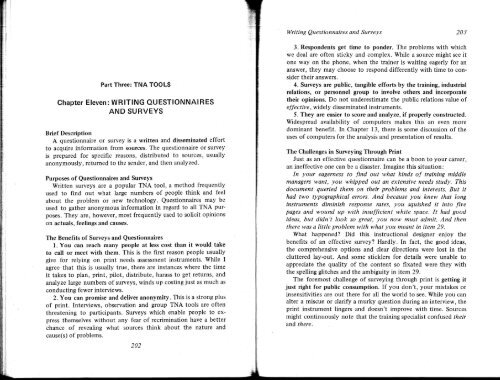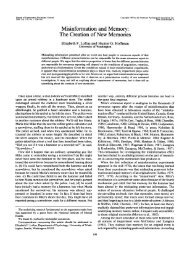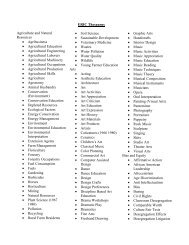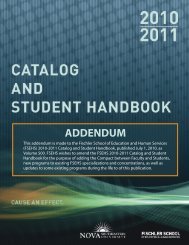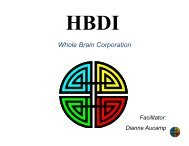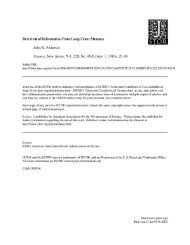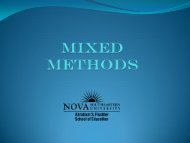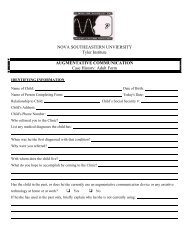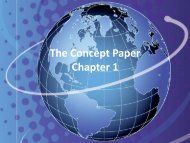Writing Questionnaires and Surveys - 1
Writing Questionnaires and Surveys - 1
Writing Questionnaires and Surveys - 1
Create successful ePaper yourself
Turn your PDF publications into a flip-book with our unique Google optimized e-Paper software.
<strong>Writing</strong> <strong>Questionnaires</strong> <strong>and</strong> <strong>Surveys</strong> 203<br />
Part Three: TNA TOOLS<br />
Chapter Eleven: WRITING QUESTIONNAI RES<br />
AND SURVEYS<br />
Brief Description<br />
A questionnaire or survey is a written <strong>and</strong> disseminated effort<br />
to acquire information from sources. The questionnaire or survey<br />
is prepared for specific reasons, distributed to sources, usually<br />
anonymously, returned to the sender, <strong>and</strong> then analyzed.<br />
Purposes of <strong>Questionnaires</strong> <strong>and</strong> <strong>Surveys</strong><br />
Written surveys are a popular TNA tool, a method frequently<br />
used to find out what large numbers of people think <strong>and</strong> feel<br />
about the problem or new technology. <strong>Questionnaires</strong> may be<br />
used to gather anonymous information in regard to all TNA purposes.<br />
They are, however, most frequently used to solicit opinions<br />
on actuals, feelings <strong>and</strong> causes.<br />
The Benefits of <strong>Surveys</strong> <strong>and</strong> <strong>Questionnaires</strong><br />
I. You can reach many people at less cost than it would take<br />
to call or meet with them. This is the first reason people usually<br />
give for relying on print needs assessment instruments. While I<br />
agree that this is usually true, there are instances where the time<br />
it takes to plan, print, pilot, distribute, harass to get returns, <strong>and</strong><br />
analyze large numbers of surveys, winds up costing just as much as<br />
conducting fewer interviews.<br />
2. You can promise <strong>and</strong> deliver anonymity. This is a strong plus<br />
of print. Interviews, observation <strong>and</strong> group TNA tools are often<br />
threatening to participants. <strong>Surveys</strong> which enable people to express<br />
themselves without any fear of recrimination have a better<br />
chance of revealing what sources think about the nature <strong>and</strong><br />
cause(s) of problems.<br />
202<br />
3. Respondents get time to ponder. The problems with which<br />
we deal are often sticky <strong>and</strong> complex. While a source might see it<br />
one way on the phone, when the trainer is waiting eagerly for an<br />
answer, they may choose to respond differently with time to consider<br />
their answers.<br />
4. <strong>Surveys</strong> are public, tangible efforts by the training, industrial<br />
relations, or personnel group to involve others <strong>and</strong> incorporate<br />
their opinions. Do not underestimate the public relations value of<br />
effective, widely disseminated instruments.<br />
5. They are easier to score <strong>and</strong> analyze, if properly constructed.<br />
Widespread availability of computers makes this an even more<br />
dominant benefit. In Chapter 13, there is some discussion of the<br />
uses of computers for the analysis <strong>and</strong> presentation of results.<br />
The Challenges in Surveying Through Print<br />
Just as an effective questionnaire can be a boon to your career,<br />
an ineffective one can be a disaster. Imagine this situation:<br />
In your eagerness to find out what kinds of training middle<br />
managers want, you whipped out an extensive needs study. This<br />
document queried them on their problems <strong>and</strong> interests. But it<br />
had two typographical errors. And because you knew that long<br />
instruments diminish response rates, you squished it into five<br />
pages <strong>and</strong> wound up with insufficient white space. It had good<br />
ideas, but didn't look so great, you now must admit. And then<br />
there was a little problem with what you meant in item 29.<br />
What happened? Did this instructional designer enjoy the<br />
benefits of an effective survey? Hardly. In fact, the good ideas,<br />
the comprehensive options <strong>and</strong> clear directions were lost in the<br />
cluttered lay-out. And some sticklers for details were unable to<br />
appreciate the quality of the content so fixated were they with<br />
the spelling glitches <strong>and</strong> the ambiguity in item 29.<br />
The foremost challenge of surveying through print is getting it<br />
just right for public consumption. If you don't, your mistakes or<br />
insensitivities are out there for all the world to see. While you can<br />
alter a miscue or clarify a murky question during an interview, the<br />
print instrument lingers <strong>and</strong> doesn't improve with time. Sources<br />
might continuously note that the training specialist confused their<br />
<strong>and</strong> there.
!<br />
!<br />
204 Training Needs Assessment<br />
You are challenged to find the right words <strong>and</strong> items. Payne, in<br />
a classic 1951 work on questionnaire design, describes research that<br />
found question writing to be the biggest problem in survey research.<br />
Payne cites Howard T. Hovde, who asked a sample of researchers<br />
what they saw as the principal defects in commercial<br />
research. Improperly worded questionnaires ranked as the number<br />
one defect, with faulty interpretation <strong>and</strong> inadequate samples<br />
lagging just behind. Three experts out of every four mentioned<br />
poorly worded items as a problem! That holds true today, I suspect.<br />
Once conceived, printed <strong>and</strong> duplicated, your questionnaire<br />
st<strong>and</strong>s as it is. You may come back with another questionnaire<br />
at a latter stage of TNA, or you may use an interview or a group<br />
meeting to follow-up. But the following-up, the digging deeper or<br />
interacting with sources' responses must come later. Print is not<br />
an immediately interactive tool, the wayan interview or group<br />
meeting is. There is no opportunity to clarify, pursue an intriguing<br />
idea or seek substantiation. You need to know what you need to<br />
know before you send the TNA tool out. After that, the survey<br />
is what it is, not what you wish it was.<br />
Once you have conceived <strong>and</strong> disseminated an effective questionnaire,<br />
you want to enjoy a hearty response rate, <strong>and</strong> often won't.<br />
In addition to the democratic desire to involve large numbers of<br />
people in your efforts, you need high response rates to employ<br />
tests of statistical significance. Even if you intend to use nothing<br />
more elaborate than percentages, it is absurd to state that "60 percent<br />
report some or strong concern with their ability to learn to<br />
hanglide" when only 1 0 out of a total population of 165 senior<br />
citizens sent back the survey. Zemke <strong>and</strong> Kramlinger (1982) claim<br />
that a usual response rate for front end analysis surveys is 15-35<br />
percent. We'll talk about strategies for assuring responses later in<br />
this chapter.<br />
A Step by Step Approach to Effective <strong>Questionnaires</strong><br />
Here are the stages for getting a good survey out <strong>and</strong> back:<br />
<strong>Writing</strong> <strong>Questionnaires</strong> <strong>and</strong> <strong>Surveys</strong> 205<br />
Step 1: Figuring Out What You Need <strong>and</strong> From Whom<br />
Step 2: <strong>Writing</strong> Effective Items<br />
Step 3: <strong>Writing</strong> Good Directions<br />
Step 4: <strong>Writing</strong> Good Cover Letters<br />
Step 5: Applying a Writer's Checklist<br />
Step 6: Piloting the Instruments<br />
Step 1: Figuring Out What You Need <strong>and</strong> From Whom<br />
1. KNOWING THE PURPOSES FOR THIS QUESTIONNAIRE<br />
It is essential to know why you are sending out this survey.<br />
Statements like, "to get a feel for the situation," or "to see<br />
where people are on the new system," or "just to let people know<br />
I care" are the harbingers of ineffective print instruments. The<br />
statements are far too broad <strong>and</strong> reflect the good intentions of<br />
trainers who aren't sufficiently clear about the problem or innovation<br />
to be writing questionnaires. A print survey is not the place<br />
to begin a foray into a new problem or topic; widely disseminated<br />
print must be reserved, in almost all cases, for later stages of<br />
front end analysis, when you have a pretty good fix on the situation,<br />
<strong>and</strong> can confidently write questions <strong>and</strong> options for answers.<br />
The training professional who confronts a blank screen <strong>and</strong> a<br />
blinking cursor, or a virgin legal pad, shouldn't be thinking about<br />
what to write. Rather, think about why you are doing this. The<br />
what will follow naturally.<br />
Concern about the purposes of the particular stage of TNA<br />
takes us back to the concepts that are the basis for this book:<br />
purpose-based front end analysis. What information are you<br />
seeking? How does what you want to know now flow from what<br />
you have found out before? Here are the familiar purposes which<br />
you might have for this stage of your inquiry. The purpose(s)<br />
then lead directly into the questionnaire items.
206 Training Needs Assessment<br />
o Finding OPTIMALS<br />
• what respondents think ought to be going on<br />
• how the system should work<br />
• what they know about it<br />
o Finding ACTUALS<br />
• the details of how employees are <strong>and</strong> are not performing<br />
• the way the system is operating<br />
• whether respondents perceive a problem<br />
o Finding FEELINGS<br />
• how this person feels about the situation<br />
• how they think others feel<br />
• confidence regarding the topic<br />
• whether they value/like the topic<br />
o Finding CAUSE(S)<br />
• what is causing the problem<br />
• which of causes detailed in Chapter 4 are in effect here<br />
o Finding SOLUTION(S)<br />
• options for how to solve the problem or implement the innovation<br />
2. ESTABLISHING A SAMPLE<br />
Who is going to get the questionnaires? Everyone? People you<br />
can depend upon to send it back? The exemplary performers?<br />
Lackluster performers? People who pick up their mail? The ones<br />
who are planning to attend a certain meeting? Or a r<strong>and</strong>om sample<br />
of the population? The first <strong>and</strong> last options are the most desirable;<br />
they are the ones which will allow you to make the strongest statements<br />
about all the people in the target learner group.<br />
There are some terms we need to get straight if we are going to<br />
seek the most desirable of sources. The first is population. It is the<br />
universe about which you are concerned. It might be major league<br />
baseball players with a documented history of drug abuse, field<br />
engineers who maintain mainframes, or bank tellers from the Bank<br />
of America. If you can, it is desirable to send print instruments to<br />
to entire population. That will cost in time <strong>and</strong> energy. It might<br />
be reasonable for the ball players <strong>and</strong> field engineers, presumin~<br />
<strong>Writing</strong> <strong>Questionnaires</strong> <strong>and</strong> <strong>Surveys</strong> 207<br />
limited numbers; it is probably not feasible for the large population<br />
of tellers.<br />
The other desirable practice is to send the instruments to a sample<br />
of the population. A sample is a small portion of the population<br />
which possesses the same characteristics as the larger group<br />
from which it is drawn. The way you assure this congruence between<br />
total population <strong>and</strong> sample is through r<strong>and</strong>omization.<br />
R<strong>and</strong>omization is the process by which you make sure that all<br />
members of the total population have an equal <strong>and</strong> fair chance<br />
of being selected to receive the survey. That must be accomplished<br />
by the blind assignment of numbers to everyone in the total<br />
population <strong>and</strong> then the lise of some computerized or blindly<br />
drawn from a hat system to select from that population in an unbiased<br />
fashion. A r<strong>and</strong>om sample is not being drawn when you<br />
send the survey out to all the middle managers <strong>and</strong> then wait to<br />
see what you get back. What you get back may well be the middle<br />
managers who perceive themselves as most expert or the ones who<br />
are most dismayed with upper management.<br />
How many do you select for your r<strong>and</strong>omly drawn sample? That<br />
takes us to the issue of sample size. Every statistics textbook presents<br />
a table of the minimum number of individuals who must be<br />
sampled to make generalizations about the larger population. The<br />
larger the total population, the smaller the percentage of individuals<br />
which must be queried.<br />
A small portion of a National Education Association table illustrates<br />
the point:<br />
Population Size<br />
100<br />
200<br />
500<br />
1,000<br />
3,000<br />
8,000<br />
15,000<br />
Sample Size<br />
79<br />
132<br />
217<br />
278<br />
341<br />
367<br />
375<br />
If we want to survey bank tellers prior to launching a major<br />
product knowledge program <strong>and</strong> there are 8,000 tellers in the<br />
population, we will need a sample size of 367 r<strong>and</strong>omly drawn
208 Training Needs Assessment<br />
respondents. And we will need an excellent response rate from<br />
them if we seek to use inferential statistics to add weight to our<br />
findings, to assure management that what we found out could not<br />
be attributed to chance.<br />
3. ASSURING NUMEROUS RESPONSES TO QUESTIONNAIRES<br />
You can increase the likelihood that you will receive a high or<br />
perfect percentage of returns by:<br />
• <strong>Writing</strong> an instrument which deals with issues of concern to<br />
the sample. Instruments which treat topics of interest only to you<br />
or upper level management are most likely to get tossed. The<br />
annual survey on telephone customer relations will get fewer responses<br />
than a questionnaire linked to extant data like recent<br />
breakdowns or sales figures.<br />
• Clearly stating the purpose(s) for this instrument. Once<br />
again, avoid, "To get a feel for the thing," or "To see where you<br />
all are." Say that you want to know the strategies people are<br />
most likely to use to sell the product or the causes for dips in<br />
sales. Tell them if there is concern about a problem <strong>and</strong> identify<br />
the survey as part of the effort to figure out the best solution.<br />
• Following through on the purposes <strong>and</strong> enjoying a reputation<br />
for doing so. There are few virgin sources out there; many<br />
of the people who will get your questionnaires have received them<br />
before. If you get a reputation for feigning interest in gathering<br />
data, or for not using what you find out from your surveys, then<br />
you are less likely to enjoy healthy response rates. Cultivate a<br />
credible history of using what you learn <strong>and</strong>, insofar as possible,<br />
of reporting back to people about what you are learning from<br />
TNA.<br />
• Making it easy to respond. Provide self-addressed envelopes,<br />
where possible, for attractively constructed, laser printed, forcedchoice<br />
instruments. Attach a stamp, if internal mail isn't an<br />
option. Remember that most sources will toss this survey at the<br />
first hint of inconvenience or confusion.<br />
• Providing a reason to send it back. This isn't always possible,<br />
<strong>and</strong> it does conflict with confidence in anonymity, but it helps<br />
to give respondents something for their efforts. The results of the<br />
survey is the st<strong>and</strong>ard return for their effort. I try to go beyond<br />
that. My colleague, Farhad Saba, <strong>and</strong> I conducted research<br />
<strong>Writing</strong> <strong>Questionnaires</strong> <strong>and</strong> <strong>Surveys</strong> 209<br />
on the ways that TNA is carried out in international settings.<br />
In order to encourage responses, we offered those who chose<br />
to respond a TNA job aid as a gift. The price we pay will be<br />
suspicion that our responses were from the neediest professionals<br />
or the most serious professionals or .... But since it is a small<br />
population from which we draw to begin with <strong>and</strong> since we did not<br />
r<strong>and</strong>omly select a sample from it, we are acknowledging the weaknesses<br />
of our sample in favor of getting descriptive information<br />
from a unique <strong>and</strong> elite cadre of training <strong>and</strong> development professionals<br />
who work abroad.<br />
• Harrassing non-respondents until they finally turn the instrument<br />
in. Sometimes it helps a little, if you use an impersonal<br />
system of writing to all members of your sample to remind them<br />
to please send the survey back. Personalized nagging, however,<br />
makes sources wonder just how anonymous they really are, no<br />
matter how much you assure them that a secretary is h<strong>and</strong>ling<br />
this part of it in a blind fashion, or that the questionnaires are<br />
numbered with a computer generating letters to non-respondents.<br />
They know <strong>and</strong> you know that the computer or secretary that<br />
begs for returns can also generate a list linking returns with respondents.<br />
Step 2: <strong>Writing</strong> Effective Items<br />
THE CONTENT FOR QUESTIONS<br />
Chapter 6 includes the section, Step 3: Creating Items. That<br />
section details the purposes which initiate surveys. Based on these<br />
broad purposes, an item typology is proposed which facilitates the<br />
generation of individual items for questionnaires or interview<br />
guides. The typology that I developed solves the problem of what<br />
to ask. When training professionals pound a stack of returns <strong>and</strong><br />
say, "I still don't know ... " or "I didn't get what I needed," or<br />
"Now what do I do with all this?"; they probably are suffering<br />
from having asked the wrong questions. Problems of content can<br />
be addressed through the item typology presented in Figure 6.2.<br />
A brief summary of the typology follows:<br />
Type 1 items ask WHAT NEED.<br />
Type 2 items ask for DETAILS.<br />
Type 3 items provide PROOF.
'i,<br />
Ii.<br />
I<br />
Iii<br />
,I<br />
I<br />
!<br />
210 Training Needs Assessment<br />
Type 4 items ask for FEELINGS <strong>and</strong> MOTIVATION.<br />
Type 5 items ask for CAUSE(S) OF THE PROBLEM.<br />
Type 6 items ask about the RESPONDENT.<br />
Every item should bear an obvious relationship to one type<br />
question or another, but every instrument need not seek every<br />
type information. It is more likely that you would have, for<br />
example, an instrument with 30 percent Type 2's, 30 percent<br />
Type 3's <strong>and</strong> 40 percent Type 5's, than that you would h~ve 20<br />
percent of each type item. And you are asking for trouble 1f you<br />
include many Type l's in a print format. The open-ended nature<br />
of Type 1 items seeks general problems <strong>and</strong> areas of nee? that<br />
should already be known to the training professional who 1S contemplating<br />
print surveys.<br />
Print is usually the wrong tool for a fishing expedition. A question<br />
like "What are the problems your people are confronting<br />
with this' equipment?" will go over much better in an interview<br />
than it will in a print survey. You need to know about the problem<br />
<strong>and</strong> the situation before you construct a PRINT survey.<br />
For example:<br />
When faced with preparing a pizza on our new computerized<br />
equipment, which of the following creates the greatest problems?<br />
Mark only one.<br />
..... a. setting the heat control<br />
. .... b. altering the homeostasis unit for deepdish vs. other<br />
..... c. order of assembly of the optional garnishes<br />
There are two dozen things that are done in the preparation of<br />
a pizza, not just a, b<strong>and</strong> c. This latter stage questionnaire o.nly<br />
focuses on the three problems which earlier TNA stages (exammation<br />
of extant data <strong>and</strong> interviews) highlighted. The pizza item is<br />
a type 2 question seeking details of a problem about which n:uch<br />
is already known. It is likely that it would be followed up w1th a<br />
Type 5 question seeking the cause of the problem or a Type.4<br />
which looks for feelings about the system. Or maybe you w1ll<br />
only use print for the Type 2's <strong>and</strong> 5's, deciding to make phone<br />
calls to solicit information on feelings about computerized pizza<br />
making <strong>and</strong> the training to do it better.<br />
In addition to questions which directly relate to the problem or<br />
new system, you might want to ask for information about the re-<br />
<strong>Writing</strong> <strong>Questionnaires</strong> <strong>and</strong> <strong>Surveys</strong> 211<br />
spondent. You might want to know in which regions he works or<br />
how many people she supervises. You might want to know what<br />
training she has taken <strong>and</strong> which job aids he uses to do his job. Or<br />
you might want to know if the respondent is male or female.<br />
Demography is sought in Type 6 items.<br />
Why do you want to know? If you have a good reason, like the<br />
desire to eventually look at whether sex has an impact on the<br />
ability to conduct performance appraisal interviews, or if the extant<br />
data is showing some differences in the appraisals based on<br />
gender, then by all means go ahead <strong>and</strong> ask about gender. Don't<br />
query about sex, age, years of service, etc., unless you know what<br />
you intend to do with the data, unless you have a good reason for<br />
the question. Make every question <strong>and</strong> inch of space count.<br />
Be certain to use the topic <strong>and</strong> the way it breaks down to<br />
cluster your items. Rather than clustering by purpose (e.g., asking<br />
three questions about the causes of the problems), chunk into the<br />
natural components of the subject matter or job. The pizza oven<br />
example might involve questions about entering data, closing<br />
down, monitoring pizzas <strong>and</strong> daily maintenance with Type 2's, 3's,<br />
<strong>and</strong> 4's in all four clusters. Use the purposes <strong>and</strong> typology to<br />
generate your items, then be sure to arrange the questionnaire on<br />
the basis of the content of the subject or job.<br />
The Formats for Questions<br />
The two basic question types are forced choice <strong>and</strong> open-ended<br />
items. A forced choice item will say "which" or "what one of the<br />
following" or "rank this list" or "rate these according to ... " You<br />
provide respondents with a fixed set of options from which they<br />
must choose. Here is an example:<br />
Which of these has caused problems when you've made pizza<br />
prior to installation of the new ovens? Check all those that have<br />
been a problem.<br />
maintaining the equipment<br />
setting up<br />
temperature control<br />
judging texture<br />
doing more than 12 pies at a time<br />
cleaning the sensors<br />
cleaning surfaces
212 Training Needs Assessment<br />
An open-ended item is just what it sounds like. It in no way<br />
narrows the range of possible responses. This is an example of that<br />
format:<br />
In what areas did you experience problems making pizza be·<br />
fore the computerized ovens were installed?<br />
You may use forced choice <strong>and</strong> open questions for item types<br />
24. Obviously, type I questions are best asked in an open format.<br />
It is possible to achieve all TNA purposes through either forced or<br />
open-ended queries. However, unless you wish to be driven mad<br />
by a flood of written data or by vague <strong>and</strong> general statements as<br />
responses to surveys, I strongly urge you to lean heavily on forced<br />
choice items for questionnaires <strong>and</strong> surveys.<br />
A compromise format is to combine forced choice <strong>and</strong> openended<br />
items. This gives you the benefits of forced questions while<br />
still leaving the door open for alternative responses. Constructed<br />
after you are pretty sure about the problem, you give the respondents<br />
choices <strong>and</strong> allow them to fill in something you may<br />
have left out. Here is an example of a combination item, an item<br />
which gives a list of choices <strong>and</strong> an opportunity for open response.<br />
Wiring in ovens is causing more problems than ever before.<br />
Circle the number which reflects your opinion on the cause of<br />
the wiring problems. Rate the list below as:<br />
2 0<br />
2 0<br />
2 0<br />
2 0<br />
2 0<br />
2 0<br />
(2) major contributing factor<br />
(1) some factor<br />
(0) no factor<br />
(a) poor quality wires<br />
(b) faulty installation<br />
(c) ineffective maintenance<br />
(d) inappropriate maintenance schedul·<br />
ing<br />
(e) if wires don't break, technicians lose<br />
jobs<br />
(f) other:<br />
Think about the pizza wiring example. Imagine that you had<br />
sent out surveys to all 160 store managers. Would you rather con-<br />
<strong>Writing</strong> <strong>Questionnaires</strong> <strong>and</strong> <strong>Surveys</strong> 213<br />
template 160 answers to the above item or to the following item,<br />
"What are the causes of the problems you are confronting with the<br />
wiring of the new computerized equipment. " Certainly an openended<br />
version of this example is appropriate for use in early stages<br />
as you meet with regional groups of managers or as you conduct<br />
telephone surveys. But in latter stages of assessment you want to<br />
confirm. That leaves you with the challenge of knowing enough<br />
about the problem to provide realistic choices <strong>and</strong> to be able to<br />
present them in a useful <strong>and</strong> appropriate format. The combination<br />
format leaves you with a way of capturing additional data without<br />
confronting 160 written paragraphs.<br />
In closed or forced questions, the item constructor has three<br />
choices with implications for data analysis:<br />
1. Nominal scales name or describe who the respondent is. If<br />
there is no order inherent in the categorization, then it is a nominal<br />
scale. For example:<br />
Check the one that applies to you ...... male ...... female<br />
Which best describes the area in which you work? Check<br />
only one.<br />
. ..... sales <strong>and</strong> marketing<br />
...... personnel <strong>and</strong> training<br />
. ..... manufacturing<br />
A question which asks you to check given IQ categories or pay<br />
ranges or number of courses that you have taught would not be a<br />
nominal scale because a rank order is perceivable.<br />
2. Ordinal scales ask respondents to select a category which reflects<br />
some ranking but lacks guaranteed, st<strong>and</strong>ard differences between<br />
ranks. For example, look at these Type 4 questions:<br />
Which best describes your confidence in your ability to clean<br />
the new computerized pizza making equipment?<br />
...... very confident<br />
...... confident<br />
...... somewhat confident<br />
...... not at all confident
214 Training Needs Assessment<br />
<strong>Writing</strong> <strong>Questionnaires</strong> <strong>and</strong> <strong>Surveys</strong><br />
215<br />
"The corporation selected the right computerized pizza<br />
makers for our stores." Check only one.<br />
...... strongly agree<br />
...... agree<br />
...... undecided<br />
...... disagree<br />
...... strongly disagree<br />
The problem with these Likert type items is the question about<br />
what constitutes the differences between options. Bradburn et al.<br />
(1979) pointed to how often we create scales like these assuming<br />
that everyone will know <strong>and</strong> share precise meanings for words like<br />
very <strong>and</strong> often <strong>and</strong> above average. In fact they don't. His research<br />
suggests that people vary in their definitions of words like rarely,<br />
sometimes <strong>and</strong> often, <strong>and</strong> that even individuals will vary in how<br />
they rate from topic to topic. There is no easy solution to the<br />
problem beyond recognition of the caveats appropriate to the use<br />
of such rating scales.<br />
Training professionals often want sources to rank not rate the<br />
options. As long as you provide no more than four choices, people<br />
usually like to do it. For example, here is another ordinal scale,<br />
a Type 5:<br />
Our stores are reporting double the number of equipment<br />
breakdowns than documented manufacturer's experience with<br />
other pizza stores. Why do you think this is happening to our<br />
chain? Below is a list of reasons that store managers have suggested.<br />
Will you please rank them from 1 to 3 with 1 represent·<br />
ing the greatest cause of breakdowns <strong>and</strong> 3 the least cause, in<br />
your opinion?<br />
...... a. improperly installed equipment<br />
...... b.poor materials in manufacture of units<br />
...... c. improper daily maintenance in stores<br />
3. Interval scales provide options in which the difference between<br />
units is equal <strong>and</strong> predictable. These are often used to gather<br />
demographic data:<br />
How many times have you attended equipment related train·<br />
ing in the past five years?<br />
...... 0<br />
. ..... 1·3<br />
...... 4·6<br />
...... 7·9<br />
...... 10-12<br />
...... more than 13 times<br />
How much money have you spent on equipment repair in the<br />
past year?<br />
...... $0·500<br />
...... $501-1000<br />
...... $1001-1500<br />
...... $1501-2000<br />
...... $2001·2500<br />
...... more than $2500<br />
There are several other concerns which relate to effective formats<br />
for items. The first is scale consistency. Avoid switching rating<br />
scales <strong>and</strong> devices in the middle of an instrument unless there<br />
is a good reason. While Zemke <strong>and</strong> Kramlinger (1982) encourage<br />
changing to combat monotony, especially in lengthy instruments,<br />
I don't agree. Instead, I would abbreviate the instrument <strong>and</strong> maintain<br />
as much consistency as possible. Respondents want to focus<br />
on the content of the questions; the scale type should be almost<br />
transparent.<br />
Two other format issues are highlighting <strong>and</strong> the use of white<br />
space. I rely heavily on the use of bold letters <strong>and</strong> underlining to<br />
inform sources about what I think is essential in an item. I also<br />
will highlight if I think a source might get confused. Here is an<br />
example of a Type 3 question which checks up on what respondents<br />
actually know:<br />
The pizza dough that is coming out of the ovens is soggy <strong>and</strong><br />
has been that way since the evening rush hour. The temperature<br />
meter reads normal for the number of pizzas being baked. Which<br />
of the following comm<strong>and</strong>s should be entered into the control<br />
panel first?<br />
...... a. REHEAT<br />
...... b.REDIRECT<br />
...... c.DISPLAY<br />
...... d. CONCENTRATE<br />
216 Training Needs Assessment<br />
It is important to produce instruments which look like you<br />
know what you are doing. White space contributes to that, as<br />
does quality copying, careful font selection <strong>and</strong> lay-out of items<br />
<strong>and</strong> scales on the page.<br />
The Words for Questions<br />
The characteristics of the population should influence your<br />
search for the right words. Select words which are familiar, without<br />
being loaded with controversial meanings. Phrases like corporate<br />
image, cooperation, <strong>and</strong> sufficient productivity have the<br />
potential of eliciting an emotional response from one source <strong>and</strong><br />
confusion about what you mean from another. In an interview<br />
you can elaborate, in print you confront denotation <strong>and</strong> connotation.<br />
Another issue is the reading grade level of the population.<br />
Keep reading grade level down by avoiding poly-syllabic words.<br />
lengthy sentences <strong>and</strong> jargon.<br />
Payne (1951) advocates brief questions, stating that if you need<br />
more than 20 words for your question, it is too long. Sometimes,<br />
however, I've seen situations where you will want to set up situations<br />
in questions which take more than 20 words. The soggy<br />
pizza is an example. You can imagine other Types 3's <strong>and</strong> type 5's<br />
which would be appropriately lengthy. The key is appropriateness,<br />
again. Aim for brevity but recognize you may need to establish a<br />
question or situation in order to get meaningful responses.<br />
Step 3: <strong>Writing</strong> Good Directions. It seems like a simple thing.<br />
Once you have gotten clear about your purposes <strong>and</strong> have crafted<br />
items appropriate to those purposes <strong>and</strong> your audience, just put<br />
in some directions which tell respondents how to complete the<br />
items. Easy, right? Wrong.<br />
Directions are supposed to clarify things for respondents.<br />
Effective directions are crisp, not redundant. Definitions are included<br />
when necessary. Directions use words which are appropriate<br />
to the audience (see Step 2) <strong>and</strong> that tell you exactly what<br />
you need to know.<br />
What do you need to know?<br />
• what you will be expected to do<br />
• whether we are talking about rating, <strong>and</strong> if so, what the<br />
rating scale is<br />
<strong>Writing</strong> <strong>Questionnaires</strong> <strong>and</strong> <strong>Surveys</strong> 217<br />
• whether we are talking about ranking, <strong>and</strong> if so, what the<br />
different numbers signify<br />
• whether you get to fill in your own ideas, as in a combinational<br />
item or in a totally open-ended query<br />
In those rare instances where you include open-ended questions<br />
in surveys, you might choose to provide model answers. Not everyone<br />
would even consider this as a possibility. The danger is that<br />
you will bias your sample by providing them with a model acceptable<br />
answer. The way I address this concern is by offering an example<br />
that is on a different topic, but which exemplifies the level<br />
of detail <strong>and</strong> specificity that I seek. For example:<br />
I n the questions that follow you will be asked to express<br />
your feelings about the pizza making equipment you are now<br />
using. Here is the kind of answer that will help us underst<strong>and</strong><br />
how you feel: "I am very impressed with the performance of my<br />
Toyota MR2. It has excellent acceleration <strong>and</strong> better than 33<br />
miles per gallon," or "That Nagasawa has never worked right. It<br />
jerks <strong>and</strong> heaves when I shift from 1st to 2nd <strong>and</strong> failed to start<br />
up 2 out of 7 days last week." Please try to provide answers<br />
which are as specific as these two automobile reactions.<br />
1. Will you please describe your feelings about the new<br />
computerized pizza ovens?<br />
2. How do the people on your staff react when you train<br />
them to operate this equipment?<br />
Only provide examples when you anticipate inaccurate or inadequate<br />
responses to your open questions. Be sure to use an<br />
example from another subject <strong>and</strong> to illustrate both ways. I spoke<br />
of the excellent features of the MR2; I also exemplified with<br />
specific weaknesses of the Nagasawa.<br />
Step 4: <strong>Writing</strong> Good Cover Letters. This is usually the first<br />
thing that the sample sees <strong>and</strong> it has to be good. What does good<br />
mean? It has to include the following:<br />
• why they have received this questionnaire<br />
The Industrial Relations group is sending this survey out to<br />
all store managers in the New Engl<strong>and</strong> area.
218 Training Needs Assessment<br />
<strong>Writing</strong> <strong>Questionnaires</strong> <strong>and</strong> <strong>Surveys</strong><br />
219<br />
i I<br />
; I<br />
i I<br />
, :<br />
,<br />
Ii<br />
II<br />
i I<br />
I I<br />
I<br />
I, !<br />
I, '<br />
I: :,<br />
r<br />
• a clear statement of the purpose of the questionnaire<br />
Sales figures <strong>and</strong> repair costs indicate there are problems with<br />
the computerized ovens. We are writing to you to find out what<br />
you think about the problem.<br />
• a reason for responding<br />
There are many ways we could solve this problem ranging<br />
from removing the ovens to training all store staff in maintenance<br />
procedures. Your answers will help us figure out which option<br />
to select.<br />
• directions about how <strong>and</strong> when to respond<br />
An envelope with my address on it is attached to the instrument.<br />
Please make sure that you put it in internal mail by the<br />
last day of this month.<br />
• say what you've done before to research the situation<br />
The ideas <strong>and</strong> choices in this questionnaire are based on repair<br />
<strong>and</strong> sales figures <strong>and</strong> interviews with 6 regional managers.<br />
• be direct, relying upon words <strong>and</strong> tone which indicate<br />
that a real person is concerned with how other real people<br />
see this issue.<br />
This survey attempts to gather details about your experience<br />
using this equipment in the field. Only you <strong>and</strong> the other store<br />
managers can provide us with that kind of information.<br />
• express appreciation for participation<br />
I appreciate the time that you will spend filling out this survey.<br />
Thank you in advance for your participation.<br />
Here is a cover letter which was written by Judy Duffield <strong>and</strong><br />
attached to a needs assessment she distributed to teachers-in-training<br />
for a language training program:<br />
I am studying second language acquisition as part of a project<br />
for a graduate class at San Diego State. Specifically I am trying to<br />
find out why more prospective teachers aren't interested in learning<br />
Spanish.<br />
I've interviewed several students <strong>and</strong> teachers, but now I need<br />
more detailed information from more people. As someone who<br />
is about to become a teacher <strong>and</strong> who speaks only English, I<br />
hope you will give me the information that I need.<br />
The attached questionnaire gives you a chance to express your<br />
opinions <strong>and</strong> feelings about learning a second language. Please<br />
remove this cover sheet, answer the questions <strong>and</strong> return it in<br />
the enclosed, stamped envelope by March 15th.<br />
Please give a few moments of your attention to this questionnaire.<br />
I intend to look carefully at your responses to see if<br />
<strong>and</strong> how we can make the prospect of learning a second language<br />
more desirable <strong>and</strong> practical for prospective teachers.<br />
Thank you very much for your time <strong>and</strong> effort.<br />
Note that this example tells what qualifies the individual to be<br />
included in the population, the purpose of the survey, <strong>and</strong> how<br />
<strong>and</strong> when to respond. She obviously needs their responses in order<br />
to make important decisions, <strong>and</strong> she expresses appreciation for<br />
their time <strong>and</strong> effort.<br />
Step 5: Applying the Questionnaire Writer's Checklist. Here is<br />
a heuristic which exemplifies the survey writing concepts covered<br />
in this chapter. Use this checklist to look at a questionnaire<br />
which was developed previously or to help you generate a new<br />
one.<br />
The cover<br />
o Purpose<br />
o Direct address<br />
o Appropriate words for audience<br />
o How selected to receive survey<br />
o Reason for responding<br />
o How <strong>and</strong> when to respond<br />
o Expression of appreciation<br />
The directions<br />
o Brief<br />
o Clear<br />
o Appropriate to the audience
: i<br />
I<br />
d<br />
i I<br />
:1:1<br />
! i<br />
I, I<br />
:j!<br />
: t<br />
220 Training Needs Assessment<br />
D Defining when necessary<br />
D Providing examples when necessary<br />
The items<br />
D One purpose per item<br />
D Each item linked to an item type<br />
D Primarily forced choice items<br />
D Reliance upon combinational items to include open ended<br />
option<br />
D Appropriate use of highlighting, underlining <strong>and</strong> white<br />
space<br />
D Consistency in scales <strong>and</strong> question types<br />
D Content clustering by meaningful portions of the job or<br />
task<br />
D Numbered items <strong>and</strong> pages<br />
D Words <strong>and</strong> sentences appropriate to reading level <strong>and</strong> interests<br />
D Communication with data processing professional, if appropriate<br />
D Sufficient piloting to revise <strong>and</strong> feel confident<br />
Step 6: Piloting the Questionnaire. Pilot your instrument before<br />
you distribute it. What you must decide is how complicated <strong>and</strong><br />
real world you want to get about it. Two variables are involved as<br />
you think about piloting: with how many will you pilot <strong>and</strong> from<br />
where you will get them. It is different to try it out on three training<br />
professionals in your office than it is to send it to three store<br />
managers.<br />
I encourage both an intimate <strong>and</strong> exp<strong>and</strong>ed piloting of surveys.<br />
An intimate pilot uses the opinions of other training professionals<br />
<strong>and</strong> managers to make improvements in the questionnaire. Ask<br />
these colleagues to read the questionnaire <strong>and</strong> give you specific<br />
suggestions as to how it might be made more effective. Consider<br />
letting them look at the checklist in Step 5 as they scrutinize your<br />
work. An exp<strong>and</strong>ed pilot actually sends the thing out to some<br />
store managers or bank tellers, not r<strong>and</strong>omly selected ones or as<br />
large a group as will constitute the final sample, but some people<br />
who are probably similar to your eventual respondents. If you<br />
can, try it on several members of the population from representative<br />
locations.<br />
r<br />
I i<br />
<strong>Writing</strong> <strong>Questionnaires</strong> <strong>and</strong> <strong>Surveys</strong> 221<br />
Oppenheimer (1982) describes a pilot of a needs assessment in<br />
an article in Training <strong>and</strong> Development. After systematic efforts<br />
to derive optimal categories for management behavior, categories<br />
which the sample would eventually rate, Oppenheimer piloted the<br />
instrument. First he distributed it to seven people from other parts<br />
of the company <strong>and</strong> made revisions. Then he sent it to some<br />
managers from across the company. Based on their comments,<br />
new <strong>and</strong> simplified directions were added. After these two cycles<br />
of piloting, Oppenheimer was able to confidently distribute his<br />
questionnaire across the corporation.<br />
Another Print TNA Tool:<br />
The Delphi<br />
Cass Gentry (1985), in a paper delivered to the Association for<br />
Educational Communications <strong>and</strong> Technology, encouraged the use<br />
of a Delphi as a needs assessment survey tool. Though I've never<br />
done it, I agree that training professionals can use a Delphi to<br />
systematically involve experts in definition of goals (optimals) <strong>and</strong><br />
descriptions of actual conditions. I think it would also be useful<br />
for gathering a broad range of opinions on the cause(s) of performance<br />
problems.<br />
During a Delphi, trainers seek information from sources about<br />
optimals, actuals <strong>and</strong> causes through repeated stages of contact<br />
based on disseminated, carefully constructed print surveys. The<br />
unusual part about the Delphi is that a chosen, elite panel of experts<br />
is repeatedly involved in offering their opinions on a narrow<br />
topic.<br />
The Delphi involves recurring submissions of a series of questions<br />
to selected individuals who remain unknown to each other.<br />
Usually, but not always, the people who receive the questionnaires<br />
are considered expert in the field. They comprise a panel<br />
which is questioned about a particular topic on several different<br />
occasions.<br />
There is an initial series of open-ended questions which solicit<br />
opinions from respondents. The answers to the original survey are<br />
then used to enlighten the construction of the next survey, which<br />
once again is sent back to the original panel. This continues over<br />
II<br />
_
222 Training Needs Assessment<br />
<strong>and</strong> over again until the person who is sending out the instruments<br />
is convinced that some clear picture or consensus has been achieved.<br />
Here is how it might be expressed in steps contributing to TNA:<br />
1. Clarify purposes for this Delphi. Are you seeking opinions on<br />
current performance? what performance ought to be? future directions?<br />
causes of impediments to performance or progress? several<br />
of these? Generate items which will accomplish these purposes.<br />
2. Select a panel. Most often this is a panel of experts. But not<br />
always. I would lean towards a panel of experts if the purpose of<br />
the Delphi is to define optimals. If the reason for the surveys is<br />
description of current practices or causes, I see no reason to insist<br />
that everyone be considered expert in the area. Experience would<br />
be sufficient in this case.<br />
3. Distribute questionnaires to panel. The Delphis in which I<br />
have participated have always involved a lengthy <strong>and</strong> flattering<br />
cover letter which emphasizes the crackerjack, honored nature<br />
of membership on the panel. Maybe that increases the number<br />
of responses. The real reason that I have chosen to respond is<br />
that I usually get asked questions about topics that interest me.<br />
4. Analyze responses. Cluster content so that trends <strong>and</strong> disagreements<br />
are prominent.<br />
5. Use analyzed data to develop <strong>and</strong> refine questionnaires in<br />
light of the purposes established in Step 1.<br />
6. Distribute again to the original panel.<br />
7. Repeat steps 4-6 until purpose(s) of the Delphi are fulfilled.<br />
A brief example might look like this:<br />
The McKinley Corporation manufactures <strong>and</strong> sells advanced<br />
electronic equipment throughout the world. They feel that they<br />
are, however, not sufficiently using microelectronic technology<br />
to enlighten their own management practices. They decide that<br />
they want to purchase systems appropriate for all management<br />
functions <strong>and</strong> then to train their people to use them. The Vice<br />
President for Personnel decides that a Delphi with h<strong>and</strong>picked<br />
external <strong>and</strong> internal consultants will help her answer these ques.<br />
tions:<br />
• What might we be using technology for today, given<br />
the functions of middle management throughout the<br />
world?<br />
<strong>Writing</strong> <strong>Questionnaires</strong> <strong>and</strong> <strong>Surveys</strong><br />
223<br />
• What hardware <strong>and</strong> software do we need to anticipate<br />
<strong>and</strong> incorporate in our plans?<br />
• What can we hope that an effective middle manager will<br />
be able to do with microelectronic technology in the<br />
middle <strong>and</strong> late 80's? in the early 1990's?<br />
She returned to her experts four times. Each time she went back<br />
to them she refined her original instrument <strong>and</strong> pressed them for<br />
more details where there was controversy or a lack of clarity. Her<br />
last survey presented detailed results of the first three <strong>and</strong> focused<br />
on technology <strong>and</strong> international management practices, since<br />
opinions <strong>and</strong> trends in that area was lacking. Fourteen months after<br />
she commenced the Delphi, she was pleased that she finally<br />
possessed a panel of experts' opinions on optimals for middle<br />
management skills relating to high technology here <strong>and</strong> abroad.<br />
Conclusion<br />
In this chapter we've looked at an important tool in the TNA<br />
arsenal: the print survey. We have examined the steps involved in<br />
creating <strong>and</strong> sending out a questionnaire <strong>and</strong> we have linked that<br />
process to the purposes for conducting front end analysis. The<br />
numerous examples of items <strong>and</strong> formats should enable you to<br />
generate more effective instruments as well as tastier pizzas.<br />
Resources<br />
Baker, R.L., <strong>and</strong> Schutz, R.E. (1972). Instructional Product Research.<br />
New York: Van Nostr<strong>and</strong>.<br />
Best, J.W. (1970). Research in Education. Englewood Cliffs, NJ:<br />
Prentice-Hall.<br />
Bradburn, N.M., Sudman, S., <strong>and</strong> Associates. (1979). Improving<br />
Interview Method <strong>and</strong> Questionnaire Design. San Francisco,<br />
CA: Jossey Bass.<br />
Gentry, C. (1985). Needs Analysis: Rationale <strong>and</strong> Technique,<br />
paper presented at the Association for Educational Communications<br />
<strong>and</strong> Technology, Anaheim, CA.<br />
Flanagan, J.e. (July 1954). The Critical Incident Technique,<br />
Psychological Bulletin, 51, 327-358.
224 Training Needs Assessment<br />
, I<br />
I<br />
Oppenheim, A.N. Questionnaire Design <strong>and</strong> Attitude Measurement.<br />
New York: Basic Books, 1966.<br />
Oppenheimer, R.J. (March 1982). An Alternative Approach to<br />
Assessing Management Development Needs, Training <strong>and</strong> Development,<br />
72-76.<br />
Payne, S.L. (1951). The Art of Asking Questions. Princeton, NJ:<br />
Princeton University Press.<br />
Raid, G.H., <strong>and</strong> Ha1adyna, T.M. A Technology for Test Item <strong>Writing</strong>.<br />
New York: Academic Press.<br />
Zemke, R., <strong>and</strong> Kramlinger, T. (1982). Figuring Things Out: A<br />
Trainer's Guide to Needs <strong>and</strong> Task Analysis. Reading, MA:<br />
Addison-Wesley.<br />
Part Four: CONCLUSION<br />
Chapter Twelve: PLANN ING TRAIN ING<br />
NEEDS ASSESSMENT<br />
Summary of the Book<br />
This is the beginning of the last part of this book. The purpose<br />
of this part of the book is to bring it all together for readers.<br />
In Chapters 1-4 of TNA we looked at familiar phrases: front<br />
end analysis; needs assessment; pre-training analysis; needs studies;<br />
problem analysis ... followed by my conceptualization for investigating<br />
performance problems <strong>and</strong> innovations.<br />
In Part Two we examined extant data analysis, needs assessment<br />
<strong>and</strong> subject matter analysis. These analysis techniques are defined<br />
<strong>and</strong> linked to the front end purposes for which they are appropriate.<br />
Part Three of TNA presented the tools we use to carry out these<br />
analyses: interviews, observations, group meetings <strong>and</strong> surveys.<br />
Detailed examples illustrate a step-by-step approach to their<br />
use.<br />
You've encountered the concepts ...<br />
• of purpose-based TNA, where we are seeking<br />
o optima1s<br />
o actuals<br />
o feelings<br />
o cause(s)<br />
o solutions<br />
• of analysis techniques<br />
o extant data analysis<br />
o needs assessment<br />
o subject matter analysis<br />
225


